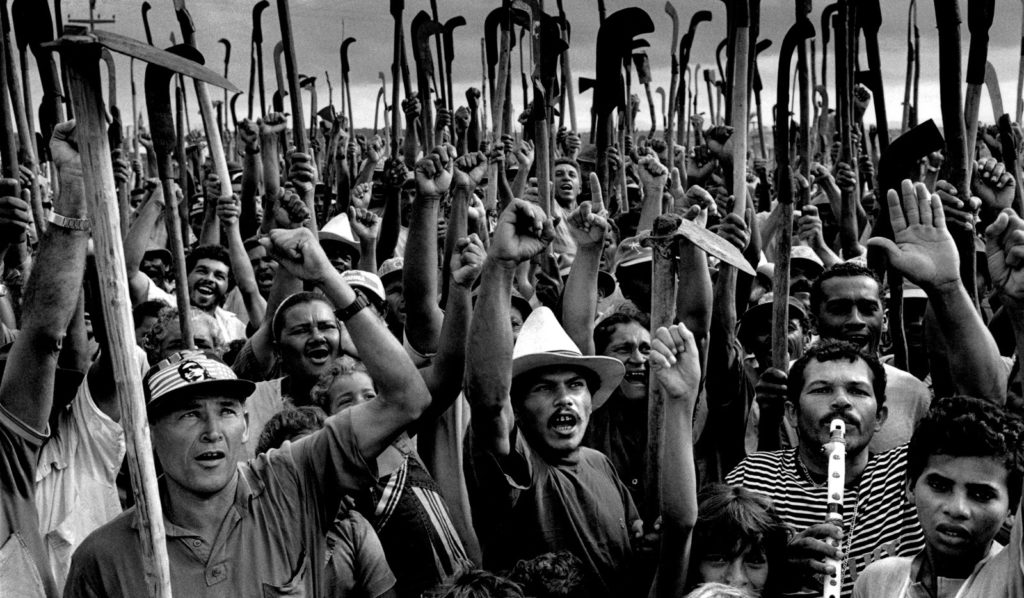
Brazil’s Landless Workers’ Movement (MST) is one of Latin America’s largest social movements, with roughly 1.5 million members. For decades the MST has operated under their slogan “Occupy, Resist, Produce” to settle landless farmers on unused land in Brazil, where roughly 3% of the population owns over 2/3 of the vast country’s arable land. In the midst of Brazil’s current political crisis, the MST continues to work for justice and against the right-wing Michel Temer government. Most recently, it has mobilized for the release of unjustly imprisoned former Brazilian President, recent presidential candidate, and Workers’ Party leader, Luiz Inácio Lula da Silva. The following is a brief overview of the history, tactics and political vision of this powerful movement.
In the early hours of the morning on October 29, 1985, 2,500 landless families arrived in trucks, buses, and motorcycles to occupy Fazenda Annoni, a roughly 23,000-acre plot of land in Rio Grande do Sul, Brazil. The families were forced to occupy the land out of desperation. For many of these activists, the alternative was grueling, slavery-like labor on large estates, or crushing poverty in city slums. Darci Bonato, a participant in the occupation, recalled that the families had only what they could carry on their backs with them to start their new lives.
We had a [grill] that we could use over an open fire, saucepans, food and bedclothes. The children had fallen asleep by the time we arrived and we laid them on a mattress under a tree, covering them with a blanket. Then we went back to the road to help guard the camp. That first night, none of the adults slept. There was a full moon, I remember, and it was quite bright. When dawn came, some policemen arrived. Strung out along the fence, we were ready to stop them coming in. There were rumors that we were armed, but we weren’t. The only weapons we had were our hoes and scythes.[1]
Police tried to in vain to push them off the land, but the activists had strength in numbers and successfully resisted the police as they continued preparing for their new lives. “People began putting up their tents, collecting water from the river, and lighting a fire for the cooking,” Bonato recalled.[2]
The police siege of the camp went on for a year, making it hard for the families to come and go, and receive food and supplies. The MST activists eventually opened up a school to teach their children, and more people joined family members in the camp as it became further established. The police blockade made it necessary for everyone in the camp to share supplies, labor, and food. At one point, children approached the police and gave them flowers, explaining that they weren’t against the police, but against the government. By 1987, the government agreed to let the farmers stay on the land. Bonato spoke of the years she spent at the camp:
I don’t regret it. If hadn’t done that, I would have worked for thirty years as a farm laborer and ended up without a single hectare. So for me it was a huge victory. Today my sons are living on the settlement with me, each with his plot of land. They lived through it all with me, and now they’re ten times better off than they would have been if I’d gone on working as a hired hand.[3]
The MST members who occupied Fazenda Annoni saw the direct rewards of their hard work, and inspired new landless activists in Brazil.
The tactics of the MST speak to the creativity and resourcefulness of its members. The ability among participants in this occupation to build a close-knit community of self-sufficient farmers, raise children, and resist the police all at once is reflective of the MST’s capacities and persistence on a national level. Over the course of the MST’s twenty-six years of work, it has expropriated over thirty-five million acres, and settled over 400,000 families.[4] The settlements, which are often cooperatively organized (with some notable exceptions), are home to hundreds of MST-built schools, which have enabled tens of thousands of people to learn to read and write.[5] As the movement has grown, it has carved its own autonomous social presence through direct action and has become a major political force in Brazil.
Occupy, Resist, Produce
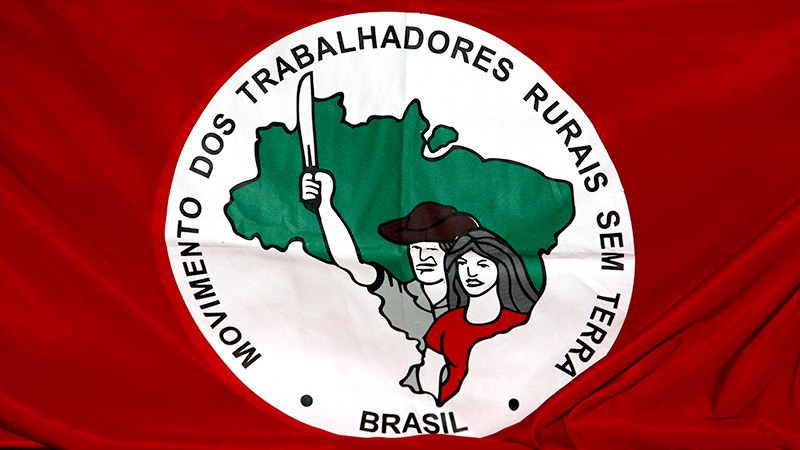
The MST began in 1984, when for four days in January, approximately one hundred landless farmers met in the southern state of Paraná. Because the organizers knew that the movement needed to be broad, landless leaders from thirteen different states were invited. This gathering was a break from the traditional land struggles, which had largely been led by unions. Many in large Brazilian labor unions believed the fight for agrarian reform should take place within union ranks—but unions didn’t accept landless farmers as members. João Pedro Stédile, the Rio Grande do Sul Secretary of Agriculture at the time, along with other participants in the meeting, saw that the entire family of a landless farmer is affected by injustice, and therefore should be empowered to define what an alternative should look like. On that basis, Stédile believed leaders should incorporate families into the movement. Thus, all members of the landless families were given rights to participate in the movement from the beginning of the MST. Besides empowering women outside of the traditional patriarchal structure, Stédile explained in 1999, “By including all members of the family, the movement acquires a remarkable potential force. Adolescents, for example, who are used to being oppressed by their fathers, realize that their votes in an assembly are as important as their father’s [vote].”[6] Over time, this breadth of membership contributed to the movement’s longevity and strength in numbers when occupying land and creating objectives that took into account the needs of all family members.
The MST – whose slogan is “Occupy, Resist, Produce” – has been peacefully occupying unused land since 1985. Typically, when the activists take over land, they develop cooperative farms and build houses, schools, and health clinics on it. They manage the land collectively in a sustainable way, as well as educate children and advance gender equality.[7] Since the founding of the movement, the MST did not just take over land, they also participated in marches, blockades, and occupations aimed at acquiring government assistance for their members, including improved access to credit, education, and healthcare. For decades, the MST has actively fought against the use of genetically modified organisms (GMO) and large-scale, industrial farming, while also working within their own camps to grow healthy food on a small-scale that generates employment for MST members.[8] Moving from its initial focus on land occupations, this diverse set of tactics and goals has helped the movement remain flexible over time, and able to adapt to new agricultural practices and changes in the political landscape of the country.
Among the reforms following the fall of the Brazilian dictatorship in 1985 was a new constitution written in 1988, establishing the right of the government to redistribute unused land to landless farmers. The land reform measure established that all land must be used for the good of society. If land does not fulfill a social function, the constitution stated, then the government reserves the right to take over and redistribute that land.[9] The institutional tool that carries out this redistribution is the National Colonization and Agrarian Reform Institute (INCRA). Once INCRA certifies that land should be redistributed, the government appropriates it by paying the landowner for the land, and in the case of MST occupations, gives the title of the property to the landless farmers. The MST has used this constitutional reform to pressure the government and INCRA to follow their own legal procedures—first by occupying the unused land, and then by demanding ownership of that land, or land nearby the encampment.[10]
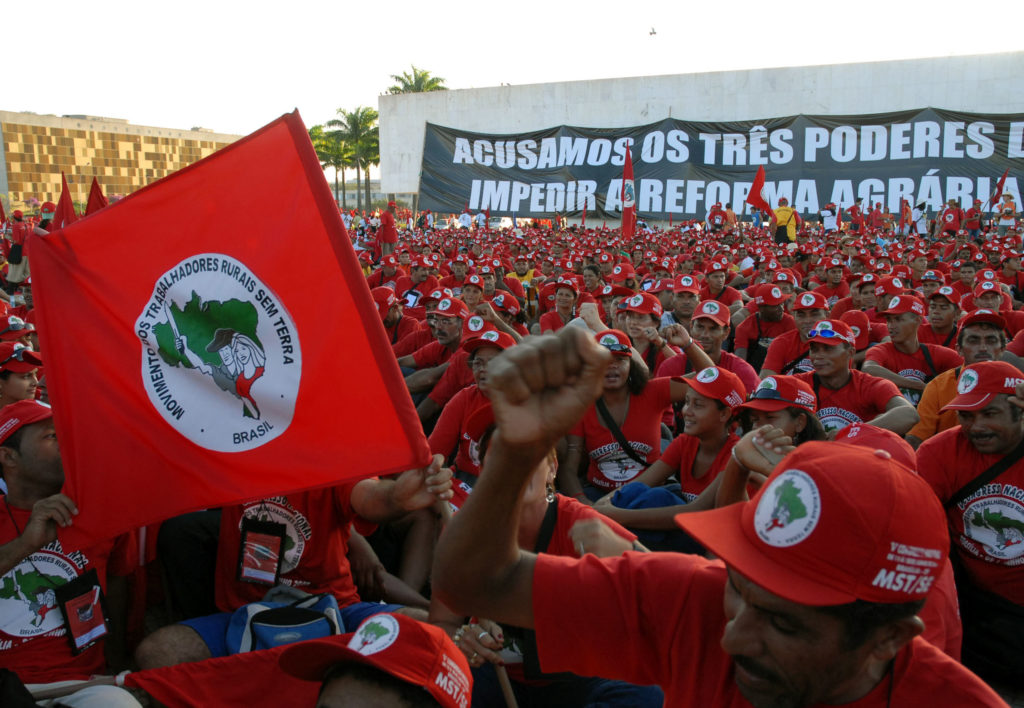
Much of the MST’s success lies in the democratic structures of its leadership, decision-making, and mobilization. Decisions and activities of the movement are debated in elected committees at various levels of the movement, ranging from the encampments to the regional offices. Within the MST, every member belongs to their own Base Group, a participatory committee that keeps power among the roots of the movement. The Base Groups in each encampment or settlement are made up of ten to twenty families, and each group has both a male and female coordinator.[11]
“That’s our democracy,” MST member João Amaral of Rio Grande do Sul, said of the Base Groups’ process and general operations. Using consensus to arrive at decisions is an important part of the Base Groups’ functionality, according to Amaral. “Perhaps that’s one of the secrets of the unity of the MST. That we have not been divided over every issue where you have to make a decision. That’s just it. We look for consensus, respecting the positions in the minority, until we arrive at consensus. There have been cases where positions which were at first in the minority became majority in the discussion process.”[12]
This emphasis on a decentralized, bottom-up approach adds to the movement’s sustainability and popularity among members. It is largely through the land occupations that MST leaders emerge; their skills are further developed in classes and meetings. The focus on bringing new leadership into the fold has spanned generations and undermines moves to centralize decision-making power in the hands of a few.
The actual occupation of land generates momentum and increases the number of MST members. Generally, once MST leaders decide on a parcel of unused land to occupy in a given area, they organize in the communities surrounding the land, describing the process INCRA goes through, and recruiting people to participate in the occupation. This community-based process brings people into the MST, incorporating participants into the necessary logistical tasks and preparation for the occupation, and then cementing relations through the solidarity that the occupation itself requires. After all of the planning is complete and the MST members decide to occupy the land, everyone is alerted at the last minute to maintain an element of surprise. Finally, participants enter the land, setting up their camp before dawn.[13] While this is a typical approach, over time MST members have also set up encampments in which people rotate through the camp during a two-to-five-year period as people are awarded land.
As Stédile explained in 2002,
On the night [of the occupation], the hired trucks arrive, well before daybreak, and go around the communities, pick up all they can carry and then set off for the property. The families have one night to take possession of the area and build their shelters, so that early the next morning, when the proprietor realizes what’s happened, the encampment is already set up. The committee chooses a family to reconnoiter the place, to find where there are sources of water, where there are trees for shade.[14]
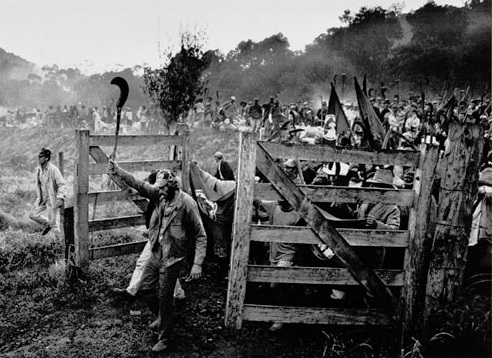
The goal is to remain in the fight in spite of any repression from police or thugs hired by the landowner: “[T]he main thing for a group, once it’s gathered in an encampment, is to stay united, to keep putting pressure on the government.”[15] The MST’s persistence and technique of direct action has been incredibly successful over the years and empowers its capacity to build an autonomous space for survival while pressuring the government at the same time.
After setting up camp, the group begins to push INCRA, court officials, and/or politicians for land. The activists often wait two to four years. In the meantime, landowners, their thugs, and police usually try to push the people off the land through harassment and assassinations. The organizational power of the MST, the solidarity of other groups that support it, and the dedication of settling families is decisive in whether or not the occupation will be successful.[16]
For many MST activists, life turns out to be better than what was suffered through before occupying the new land. Sonia Bergamasco, a professor of agrarian engineering at Campinas State University and the author of an MST settlement survey, said, “95 percent of people respond that they’re better off now [after entering a settlement]. At least they have housing, they grow food and their kids go to school. Once they’re settled, one of the first things communities do is start a school.”[17]
The difficulty of life in the encampments pushes some to leave, but the adversity also brings MST members together. The living conditions are often tough in the camps, with plastic homemade tents to live in and poor water supplies. It is hard to remain healthy and prevent the spread of illness when an encampment is far from a hospital. To inspire solidarity, educate the children, and strengthen the will to stay in the fight, MST committees organize dances, soccer games, and theater performances.[18]
Pacote, an MST member, recalled,
We lost what little we had when we went to the encampment. We could take little even of those few things we owned into the new encampment, the only thing we took was our [wood-burning] cook stove. What little savings we had were soon gone, because we were earning nothing. We had no house or land to return to, no household goods, hardly any clothing, very few of our tools—everything was lost. And there was no way to go back and be the same person again to the old neighbors, the friends on the outside. Everything depended on the future and on the friends we had made in the encampment. There was no way back.[19]
In general, for people living in squalor or essentially enslavement as farm laborers, in slums, facing fierce poverty, drug addiction, crime, and lack of education and healthcare for their families, the MST encampments have been a clear improvement.[20]
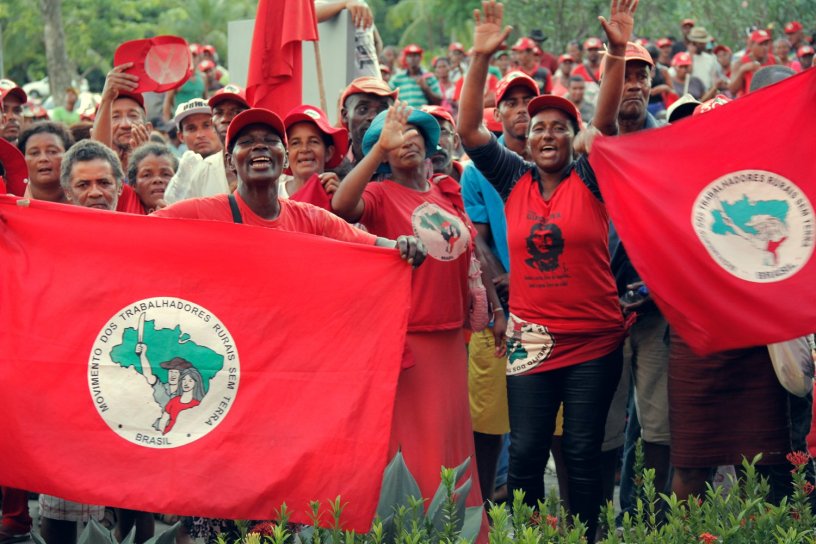
At first, the MST’s main focus was the fight for land. But quickly the activists discussed the need to educate their children to be able community members. The MST families wanted an empowering education for their children, so they could, “fight for their rights, to work together, to value the healthy life they could live in the country and to resist the lure of the city.” The movement decided they needed to set up their own, more liberating education system. In 1990, they developed their aims for this system, which focused on training new leaders, showing the reality of society and how it can be changed, in addition to classes in reading, writing, and analytical skills. Problems arose if children attending distant schools moved around a lot from camp to camp, and if the schools were outdoors, children were exposed to the elements. In response to such difficulties, MST activists set up itinerant schools in which teachers traveled with all of their supplies, including blackboards and desks.[21]
In March of 1998, when the police evicted MST members from a camp in Rio Grande do Sul, the activists decided to march to the state capital in protest. The itinerant schools went with them, operating in various settings along the march. One teacher described this educational experience:
Our desks and seats were the hard, cold ground, the blackboard was a piece of paper taped to the wall, to the railings, to the trees or just held in the teacher’s hand. We learned by seeing, living, and doing. We calculated the kilometers, meters, centimeters of the road we had to take, the number of days it would take to arrive in the capital, what was produced in the towns we went through… We saw cars, horses, carts, trains, planes, a helicopter, boats, ships, so we studied means of transport. We sang in front of 2,000 people [at the teachers’ union assembly in Porto Alegre]… When we decided to write a letter to the governor, we talked about the theme, we wrote about it, each one giving an idea, then it was read and approved by the collective school.[22]
This educational approach is illustrative of the MST’s general focus on providing an alternative to the state and traditional Brazilian institutions. In the classroom, the farming fields, and the meetings, the MST has built its own world without waiting for the right election results, policy change, or political party backing; it has taken matters into its own hands to build the society it needs to survive and thrive.
“In whatever society, and even more so in Brazil, social change doesn’t depend on the government but on the organization and the mobilization of society. It is the people that make the change,” noted Stédile. “The people have to realize that it’s useless looking to the government for everything. The government forms part of society and it’s preferable that it’s progressive… But the essential changes of society do not come from the government but from the energies that the working class succeeds in mobilizing when organizing for its rights.”[23]
This article is excerpted and adapted from Dancing with Dynamite: Social Movements and States in Latin America by Benjamin Dangl, (AK Press, 2010).
Benjamin Dangl has a PhD in Latin American history from McGill University and has worked as a journalist throughout Latin America for over a decade, writing for outlets such as The Guardian, Al Jazeera, The Nation, and Vice. He is the author of the books The Price of Fire: Resource Wars and Social Movements in Bolivia, Dancing with Dynamite: Social Movements and States in Latin America, and the forthcoming The Five Hundred Year Rebellion: Indigenous Movements and the Power of History in Bolivia, all with AK Press. Dangl edits TowardFreedom.org, a progressive perspective on world events, and teaches journalism at Champlain College in VT. Email BenDangl(at)gmail.com. Twitter @BenDangl
Notes:
[1] Quoted in Sue Branford and Jan Rocha, Cutting the Wire: The Story of the Landless Movement in Brazil (London: Latin America Bureau, 2002), 35–36. Encruzilhada Natalino, located near the Fazena Annoni, was the first MST encampment: “History of the MST,” MSTBrazil.org, http://www.mstbrazil.org/?q=history.
[2] Quoted in Branford and Rocha, Cutting the Wire, 35–36.
[3] Quoted in Ibid., 37–39.
[4] Michael Fox, “Brazil’s Landless Movement Turns 25, Opens ‘New Phase’ of Struggle,” Upside Down World, January 28, 2009, http://upsidedownworld.org/main/ content/view/1688/63/.
[5] For example, at Fazenda Annoni some families are organized into coops, while others are not and farm their own 20 hectares.
[6] Quoted in Branford and Rocha, Cutting the Wire, 21–23.
[7] “About the MST,” MSTBrazil.org, http://www.mstbrazil.org/?q=about.
[8] “History of the MST.”
[9] Richard Plevin, “The World Bank Project Subverts Land Reform in Brazil,” Global Exchange, August 6, 1999, http://www.mstbrazil.org/wbsubverts.html.
[10] Matthew Flynn, “Brazil’s Landless Workers Movement,” Americas Program, April, 2003, http://americas.irc-online.org/citizen-action/series/06-mst_body.html.
[11] Sílvia Leindecker and Michael Fox, Beyond Elections: Redefining Democracy in the Americas (Oakland: PM Press/Estreito Meios Productions, 2008), http://www. beyondelections.com/. Interview from documentary segment at: http://www. youtube.com/watch?v=dK0IAM-DIaA.
[12] Quoted in Ibid.
[13] Flynn, “Brazil’s Landless Workers Movement.”
[14] Joao Pedro Stédile, “Landless Battalions,” New Left Review, May/June 2002, http://www.newleftreview.org/A2390.
[15] Ibid.
[16] Melissa Moore, “Now It Is Time: The MST and Grassroots Land Reform in Brazil,” Food First, March 8, 2003, http://www.foodfirst.org/en/node/49.
[17] Quoted in Bill Hinchberger, “The Brazilian Landless Workers Movement (MST),” The Nation, March 2, 1998, http://www.brazilmax.com/news.cfm/tborigem/fe_society/id/29.
[18] Angus Lindsay Wright and Wendy Wolford, To Inherit the Earth: The Landless Movement and the Struggle for a New Brazil (Oakland: Food First Books, 2003), 46–51
[19] Quoted in Ibid., 54, 264.
[20] Ibid.
[21] Branford and Rocha, Cutting the Wire, 114–118. Also see Michael Fox, “Landless Women Launch Protests Across Brazil,” NACLA Report on the Americas, March 12, 2009, https://nacla.org/node/5611.
[22] Quoted in Branford and Rocha, Cutting the Wire, 119.
[23] Quoted in Marc Saint-Upéry, El Sueño de Bolívar: El Desafío de Las Izquierdas Sudamericanas (Barcelona: Paidós, 2008), 65–67.
